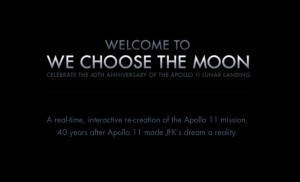Replaying History for Education
[fusion_builder_container hundred_percent=”yes” overflow=”visible”][fusion_builder_row][fusion_builder_column type=”1_1″ background_position=”left top” background_color=”” border_size=”” border_color=”” border_style=”solid” spacing=”yes” background_image=”” background_repeat=”no-repeat” padding=”” margin_top=”0px” margin_bottom=”0px” class=”” id=”” animation_type=”” animation_speed=”0.3″ animation_direction=”left” hide_on_mobile=”no” center_content=”no” min_height=”none”]
The hoopla on the 40th Anniversary of Apollo 11 got me into thinking about replaying history for education.I think that We Choose the Moon is a great example of how technology of 2009 can be used to engage the public, and more importantly school age students, in history. There’s something visceral about the “real-time” replay–the events on the website, the replay of the audio transmissions, Twittering the important events from the mission, and so on.
One of the challenges to replaying history for much of the U.S. educational system is that classes run from August/September through May/June. Thus the historical events need to occur during the typical school year. Also a challenge is the school day and week days in general.
The Apollo 11 mission is a perfect example, they’re playing the events as they happened. Sometimes the “interesting” events happen at night, sometimes on the weekend. There’s a certain serendipity to not knowing when a radio transmission is going to come in, or when an important activity happens. But, it’s hard to develop educational materials around the unknown. The event itself is constrained, the events happened over a two week period of time. Long enough to be very immersive, but short enough to keep interest.
So, what could be improved from an educational standpoint?
- Make each playback “live” and “recorded”. That is, do the real-time thing on the days and over the exact same time period that occurred in history. But also give educators a way of replaying the events during the school term.
- Provide a full timeline of events for educators. In the “live” playback they would be able to know when events are about to occur.
- Translate the playback timeline into a current time and day. The We Choose the Moon site says an activity will happen in 74 hours: 59 minutes: 20 seconds. Let me see what current day and time that activity will occur.
- After those two, give the “recorded” versions the ability to speed up time, to place key historical events at times and dates that fit within a target class period. Yes, this sort of defeats the purpose of the real-time playback, but it makes it much easier to schedule discussions of the historical events. Some of these could even be outside the class period so students would have to follow along and could do homework based on the activities.
- Develop lesson plans and activities around the historical activity. As a one-off, We Choose the Moon is an incredible resource around which one could create compelling educational activities.
- In the anniversary style real-time playback, add a social dimension, to capture the thoughts and reflections of people that experienced the event. Let the public describe their hopes and fears as they remember where they were when…
Hrm, maybe that’s an interesting educational hook, “Where were you when…Replaying History.”
One of my first posts was Where was I when… and covered topics like the Space Shuttle Challenger explosion, Loma Prieta Earthquake, 9/11 and the Death of Princess Diana would all make interesting replays for history. There are more, like the Civil War, or the Cuban Missile crisis that my friends Tom and Marion are tweeting at TwHistory.
So, if I were to propose a project around these ideas:
- Select historical events that play out in a time-bounded way that’s amenable to creating a real-time history and that have interesting educational significance.
- Tie in events with significant anniversarys of their occurrence.
- Create rich media materials to support the historical event (the expensive part). Use primary source materials, and tie in to materials across the Web.
- Create a playback engine to support the activities (another expensive part).
- Work with educators to create learning materials.
- Test the process, rinse and repeat.
These are probably best for the K-12 space in the U.S., though they could clearly be done at the higher education level.
Just some thoughts.
[/fusion_builder_column][/fusion_builder_row][/fusion_builder_container]


